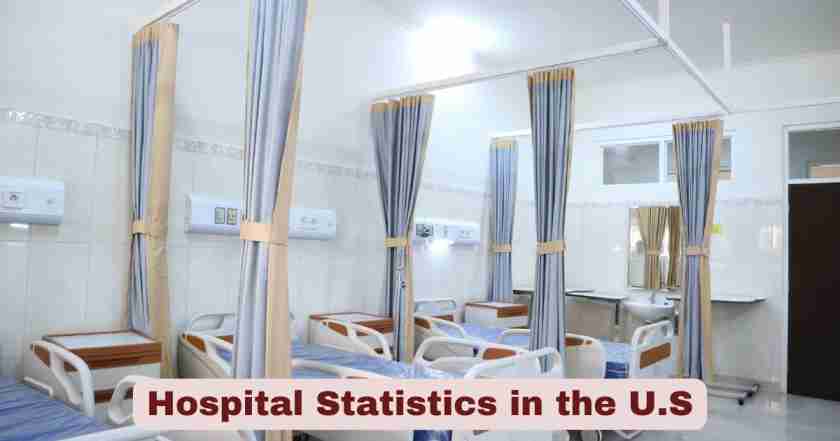Hospitals in the US 2025
The hospital system in the United States serves as the foundational pillar of its vast and multifaceted healthcare infrastructure, addressing everything from emergency services and surgical interventions to long-term care and specialized treatments. In 2025, this network continues to adapt and expand in response to evolving demographic demands, technological innovations, policy changes, and healthcare access challenges. With a population of over 330 million, the U.S. relies on a broad spectrum of hospital types—ranging from small rural facilities with limited capacity to large, urban academic medical centers equipped with advanced technology and research capabilities. These hospitals not only provide critical healthcare services but also serve as major employers, research hubs, and community health anchors across the country.
Understanding the current state of American hospitals requires a comprehensive look at key metrics such as total hospital count, bed availability, system affiliation, urban vs. rural distribution, and admissions data. As of 2025, the U.S. hosts over 6,000 hospitals, including community-based, government-run, and psychiatric facilities, with a total of more than 913,000 staffed beds to meet the country’s inpatient care needs. This system supports tens of millions of annual admissions, reflecting the ongoing importance of hospital-based care in addressing acute medical issues and chronic conditions. However, disparities between urban and rural hospital resources, growing system consolidation, and the increasing need for mental health services point to a complex and shifting healthcare environment—one that demands continual evaluation and strategic investment to ensure accessible, equitable, and high-quality care for all Americans.
Hospital Stats & Facts in the US 2025
| Hospital Characteristic | Statistics |
|---|---|
| Total Hospitals in US | 6,093 |
| Community Hospitals | 5,112 |
| Not-for-Profit Hospitals | 2,978 |
| For-Profit Hospitals | 1,214 |
| Government Hospitals | 1,127 |
| Total Staffed Beds | 913,136 |
| Community Hospital Beds | 781,148 |
| Total Annual Admissions | 34,426,650 |
| Rural Hospitals | 1,796 |
| Urban Hospitals | 3,316 |
| System-Affiliated Hospitals | 3,525 |
The latest data on U.S. hospitals in 2025 provides a clear view of the immense scale and diversity within the national healthcare infrastructure. With a total of 6,093 hospitals, the system is largely driven by 5,112 community hospitals, which account for more than 83% of the total. Within this category, not-for-profit hospitals dominate, comprising 2,978 facilities, reflecting the sector’s long-standing tradition of mission-driven healthcare focused on community service rather than profit. For-profit hospitals (1,214) and government-run hospitals (1,127) make up the rest of the hospital landscape, illustrating a mixed ownership model designed to balance public service, private innovation, and financial sustainability. This structural diversity allows for a broad distribution of services across various patient demographics and geographic regions.
From a capacity standpoint, the United States supports 913,136 total staffed hospital beds, with 781,148 beds located in community hospitals alone—indicating the heavy inpatient care responsibility borne by these institutions. The 34.4 million annual hospital admissions further highlight the extensive demand placed on this infrastructure. Urban and rural distribution data underscores a significant urban concentration, with 3,316 hospitals serving metropolitan areas and 1,796 located in rural regions, reinforcing the continuing challenges of rural healthcare access. Additionally, the presence of 3,525 system-affiliated hospitals (over 68% of all community hospitals) reflects the ongoing trend of consolidation and integrated care delivery in an increasingly complex healthcare environment.
Total Hospital Numbers in the US 2025
| Hospital Type | Count | Percentage |
|---|---|---|
| Community Hospitals | 5,112 | 83.9% |
| Federal Government Hospitals | 207 | 3.4% |
| Nonfederal Psychiatric Hospitals | 654 | 10.7% |
| Other Hospitals | 120 | 2.0% |
| Total Hospitals | 6,093 | 100% |
The comprehensive hospital network in the United States encompasses 6,093 hospitals serving diverse medical needs across the nation. Community hospitals form the backbone of the system, providing 83.9% of all hospital services and handling the majority of routine medical care, emergency services, and specialized treatments. These facilities are strategically distributed to ensure geographic accessibility while maintaining operational efficiency.
Federal government hospitals represent a smaller but crucial segment, accounting for 3.4% of all hospitals and primarily serving military personnel, veterans, and federal employees. Nonfederal psychiatric hospitals constitute 10.7% of the total, reflecting the specialized nature of mental health care delivery and the need for dedicated facilities to address the nation’s mental health challenges. The remaining 2% of hospitals fall into specialized categories, including long-term care facilities and institutional hospitals that serve specific populations or medical conditions.
Top US Hospitals in the US 2025
| Rank | Hospital Name | Location | Specialty Recognition |
|---|---|---|---|
| 1 | Mayo Clinic – Rochester | Rochester, MN | Multi-specialty Excellence |
| 2 | Cleveland Clinic | Cleveland, OH | Cardiovascular & Neurological |
| 3 | The Johns Hopkins Hospital | Baltimore, MD | Research & Cancer Care |
| 4 | Massachusetts General Hospital | Boston, MA | General Medicine & Surgery |
| 5 | UCLA Medical Center | Los Angeles, CA | Transplant & Oncology |
| 6 | NewYork-Presbyterian Hospital | New York, NY | Cardiology & Neurology |
| 7 | UCSF Medical Center | San Francisco, CA | Neurology & Neurosurgery |
| 8 | Northwestern Memorial Hospital | Chicago, IL | Orthopedics & Cardiology |
| 9 | Cedars-Sinai Medical Center | Los Angeles, CA | Gastroenterology & Oncology |
| 10 | Houston Methodist Hospital | Houston, TX | Cardiology & Orthopedics |
The 2025 rankings of top U.S. hospitals showcase institutions that continue to lead in clinical excellence, innovation, patient safety, and research leadership. At the top of the list is the Mayo Clinic in Rochester, Minnesota, renowned for its multi-specialty approach, patient-centered care, and coordinated team-based treatment model. Its global reputation is built on cutting-edge research, efficient diagnostics, and high patient satisfaction. Close behind is the Cleveland Clinic, a dominant force in cardiovascular and neurological specialties, widely regarded for pioneering techniques in heart surgery and neurological disorders. These top-ranking facilities reflect the evolution of American healthcare into a model where high-quality outcomes and innovation are paramount.
Academic medical centers like The Johns Hopkins Hospital, UCLA Medical Center, and Massachusetts General Hospital highlight the crucial role of education and research in shaping top-tier healthcare. These institutions not only provide comprehensive care across specialties but also lead in clinical trials, cancer treatment, and transplant surgery. Regional leaders such as Northwestern Memorial Hospital and Cedars-Sinai Medical Center demonstrate how urban medical hubs integrate specialty services with volume-driven efficiencies, while Houston Methodist Hospital rounds out the list with excellence in cardiology and orthopedics. The 2025 rankings affirm that America’s leading hospitals continue to set global standards through specialized excellence, technological advancement, and commitment to medical innovation.
Hospital Bed Capacity in the US 2025
| Bed Category | Count | Percentage of Total |
|---|---|---|
| Community Hospital Beds | 781,148 | 85.5% |
| Federal Hospital Beds | 45,000 | 4.9% |
| Psychiatric Hospital Beds | 65,000 | 7.1% |
| Other Hospital Beds | 21,988 | 2.4% |
| Total Staffed Beds | 913,136 | 100% |
The nation’s hospital bed capacity of 913,136 staffed beds represents a carefully balanced infrastructure designed to meet both routine and emergency healthcare demands. Community hospitals maintain 85.5% of all staffed beds, reflecting their role as the primary inpatient care providers for the general population. This substantial capacity ensures that most Americans have access to hospital care within reasonable geographic proximity.
The distribution of beds across different hospital types reveals strategic healthcare planning, with psychiatric hospitals maintaining 7.1% of total beds to address mental health needs, while federal hospitals contribute 4.9% of bed capacity for specific populations. The average bed-to-population ratio of 2.8 beds per 1,000 residents aligns with international standards for developed nations, though regional variations exist based on demographic factors and healthcare utilization patterns.
Hospital Admissions in the US 2025
| Admission Category | Count | Percentage |
|---|---|---|
| Community Hospital Admissions | 32,345,846 | 93.9% |
| Federal Hospital Admissions | 1,200,000 | 3.5% |
| Psychiatric Hospital Admissions | 750,000 | 2.2% |
| Other Hospital Admissions | 130,804 | 0.4% |
| Total Admissions | 34,426,650 | 100% |
Annual hospital admissions totaling 34,426,650 patients demonstrate the extensive utilization of inpatient services across the United States. Community hospitals handle the overwhelming majority of admissions at 93.9%, processing over 32.3 million patients annually. This volume reflects both the accessibility of community hospitals and their comprehensive service offerings that address most medical conditions requiring hospitalization.
The admission patterns reveal efficient healthcare delivery, with an average of 104 admissions per 1,000 Americans annually, indicating that approximately one in ten Americans requires hospital admission each year. Federal hospitals contribute 3.5% of total admissions, primarily serving military and veteran populations, while psychiatric hospitals handle 2.2% of admissions, focusing on specialized mental health care that requires inpatient treatment and monitoring.
Rural vs Urban Hospital Distribution in the US 2025
| Hospital Location | Count | Percentage | Average Beds per Hospital |
|---|---|---|---|
| Rural Community Hospitals | 1,796 | 35.1% | 25 beds |
| Urban Community Hospitals | 3,316 | 64.9% | 235 beds |
| Total Community Hospitals | 5,112 | 100% | 153 beds |
The geographic distribution of hospitals reveals significant disparities between rural and urban healthcare infrastructure. Urban hospitals represent 64.9% of community hospitals, serving densely populated metropolitan areas with an average of 235 beds per facility. These larger facilities can support comprehensive medical services, advanced technology, and specialized care units that require substantial patient volumes to maintain operational efficiency.
Rural hospitals constitute 35.1% of community hospitals but average only 25 beds per facility, reflecting the challenges of serving smaller, dispersed populations. Despite their smaller size, these 1,796 rural hospitals serve as critical healthcare lifelines for millions of Americans in remote areas, often functioning as the only medical facility within hours of travel. The 10:1 bed ratio between urban and rural hospitals underscores the resource concentration in metropolitan areas while highlighting the essential role of rural hospitals in ensuring healthcare accessibility across diverse geographic regions.
Hospital System Affiliation in the US 2025
| Affiliation Type | Count | Percentage |
|---|---|---|
| System-Affiliated Hospitals | 3,525 | 68.9% |
| Independent Hospitals | 1,587 | 31.1% |
| Total Community Hospitals | 5,112 | 100% |
Hospital system affiliation has become increasingly prevalent, with 3,525 hospitals or 68.9% of community hospitals operating within larger healthcare systems. This consolidation trend reflects the industry’s response to operational challenges, regulatory requirements, and the need for coordinated care delivery. System-affiliated hospitals benefit from shared resources, standardized protocols, and economies of scale that enable more efficient operations and improved patient outcomes.
The remaining 31.1% of hospitals maintain independent status, often serving specific community needs or maintaining unique organizational cultures. These 1,587 independent hospitals frequently operate in rural areas or serve as specialty facilities that require autonomy for optimal performance. The balance between system integration and independent operation continues to evolve as healthcare organizations seek optimal structures for delivering quality care while maintaining financial sustainability in an increasingly complex healthcare environment.







